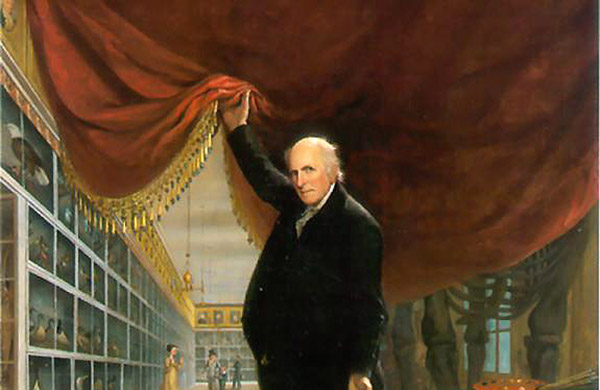His classic portraits of famous early American leaders remain widely recognized, but Peale’s promotion of natural history may be his most important legacy.
Charles Willson Peale was one of the foremost portrait painters of young America. At midlife, his attention was diverted to natural history, a novel but increasingly popular field of public interest.
Today, Peale is known for both of his contributions to the American story: capturing the country’s founders and innovators on canvas, and unveiling samples of the natural realm to curious visitors to his museum.
Peale the Patriot & Portraitist
Charles Willson Peale was born 15 April 1741 in Queen Anne’s County, Maryland. As a young man, he first tried earning his living as a saddler in Annapolis. By one account, English loyalist patrons suspected him of involvement in independence activities and forced him out of business.
Perhaps it was just as well. Peale’s gifts were in other directions. He taught himself to paint, studying the techniques of John Hesselius and John Singleton Copley. At 26, he obtained funding from a growing number of patrons to sail to London to study under artist Benjamin West.
If the English hoped to adopt a loyalist painter from the American colonies, they were misguided. William Pitt was one of his earliest portrait subjects during his tenure in London. Returning to the colonies just before the Revolution, he began painting notable patriot leaders. He also served in the colonial militia.
During the American Revolution and afterward, Peale painted many of the nation’s founders—from George and Martha Washington to numerous less-remembered shapers of the new republic. Peale painted some 60 portraits of Washington, all based on seven actual sittings.
He became known as the “artist of the American Revolution.” He painted more than a thousand portraits of early American leaders. At Independence Hall in Philadelphia in 1802, he instituted a museum to preserve the images he’d recorded.
America’s First Natural History Museum
Meanwhile, Peale had been turning his interests to natural history. He originally revealed his personal, pioneering collection as a house museum. He hoped, he said, that the collection of items displayed at his Philadelphia home would constitute a “school of useful knowledge” for visitors.
Among other endeavors, Peale was a self-taught taxidermist. His museum displayed stuffed birds and animals—and a reconstruction of a prehistoric mastodon. He personally had helped uncover its bones on an expedition in upstate New York.
His museum included, of course, some of his dignitary portraits. His heart, however, clearly was in the “Wonderful Works of Nature” category. He carefully classified the specimens he displayed. Ultimately, the museum housed more than 100,000 items.
The Legacy of Charles Willson Peale
Peale retired to farming in 1810—but he also became an inventor. He developed a variation of the “velocipede,” a bicycle-like contraption. He experimented with fireplace and bridge innovations, among other ideas.
Peale died 22 February 1827.
P.T. Barnum generally is remembered as the greatest showman-promoter in American history. Peale was a worthy predecessor. In fact, many of the items from Peale’s museum ended up among Barnum’s exhibits.
Sources:
- Maryland State Archives Web Site.
- “The Peale Family Papers.” Smithsonian Institution Web Site.








